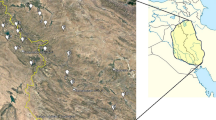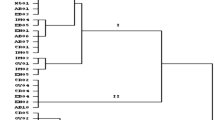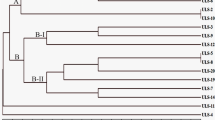Abstract
Genetic diversity is essential for survival and adaptation of high altitude plants such as those of Tanacetum genus, which are constantly exposed to environmental stress. We collected flowering shoots of ten accessions of Tanacetum gracile Hook.f. & Thomson (Asteraceae) (Tg 1–Tg 10), from different regions of cold desert of Western Himalaya. Chemical profile of the constituents, as inferred from GC–MS, exhibited considerable variability. Percentage yield of essential oil ranged from 0.2 to 0.75% (dry-weight basis) amongst different accessions. Tg 1 and Tg 6 were found to produce high yields of camphor (46%) and lavandulol (41%), respectively. Alpha-phellendrene, alpha-bisabool, p-cymene and chamazulene were the main oil components in other accessions. Genetic variability among the accessions was studied using RAPD markers as well as by sequencing and analyzing nuclear 18S rDNA, and plastid rbcL and matK loci. The polymorphic information content (PIC) of RAPD markers ranged from 0.18 to 0.5 and the analysis clustered the accessions into two major clades. The present study emphasized the importance of survey, collection, and conservation of naturally existing chemotypes of medicinal and aromatic plants, considering their potential use in aroma and pharmaceutical industry.




Similar content being viewed by others
References
Abad MJ, Bermejo P, Valverde S, Villar A (1994) Anti-inflammatory activity of hydroxyachillin, a sesquiterpene lactone from Tanacetum microphyllum. Planta Med 60:228 – 31
Abad MJ, Bermejo P, Villar A (1995) An approach to the genus Tanacetum L. (Compositae): phytochemical and pharmacological review. Phytother Res 9:79–92
Ahmadi L, Mirza M, Shahmir F (2002) The volatile constituents of Artemisia marschaliana sprengel and its secretory elements. Flavour Fragr J 17:141–143
Bagci E, Kursat M, Kocak A, Gur S (2008) Composition and antimicrobial activity of the essential oils of Tanacetum balsamita L. subsp. balsamita and T. chiliophyllum (Fisch. et Mey.) Schultz Bip. var. chiliophyllum (Asteraceae) from Turkey. J Essent Oil Bear Pl 11:476–484
Bardakci F (2001) Random amplified polymorphic DNA (RAPD) markers. Turk J Biol 25:185–196
Baser KHC, Demirci B, Tabanca N, Ozek T, Goren N (2001) Composition of the essential oils of Tanacetum armenum (DC.) Schultz Bip., T. balsamita L. T. chiliophyllum (Fisch. & Mey) Schultz Bip. var. chiliophyllum and T. haradjani (Rech. fil.) Grierson and the enantiomeric distribution of camphor and carvone. Flavour Fragr J 16:195–200
Beauchamp P, Dev V, Kashyap T, Melkani A, Mathela C, Bottini AT (2001) Composition of the essential oil of Tanacetum nubigenum Wallich ex DC. J Essent Oil Res 13:319–323
Chahota RK, Sharma V, Ghani M, Sharma TR, Rana JC, Sharma SK (2017) Genetic and phytochemical diversity analysis in Bunium persicum populations of north-western Himalaya. Physiol Mol Biol Plants 23:429–441
Chanotiya CS, Sammal SS, Mathela CS (2005) Composition of a new chemotype of Tanacetum nubigenum. Indian J Chem 44(B):1922–1926
Chauhan RS, Nautiyal BP, Nautiyal MC (2013) Trade of threatened Himalayan medicinal and aromatic Plants-socioeconomy, management and conservation issues in Garhwal Himalaya, India. Global J Pathol Microbiol 13:9–18
Christaki E, Bonos E, Giannenas I, Florou-Paneri P (2012) Aromatic plants as a source of bioactive compounds. Agriculture 2:228–243
Ciccarelli D, Garbari F, Pagni AM (2008) The flower of Myrtus communis (Myrtaceae): secretory structures, unicellular papillae, and their ecological role. FLORA 203:85–93
Committee on drugs (1994) Camphor revisited: focus on toxicity. Pediatrics 94:127–128
Croteau R, Shaskus J (1985) Biosynthesis of monoterpenes: demonstration of a geranyl pyrophosphate:(-)-bornyl pyrophosphate cyclase in soluble enzyme preparations from tansy (Tanacetum vulgare). Arch Biochem Biophys 236:535–43
Dar MY, Shah WA, Rather MA, Qurishi Y, Hamid A, Qurishi MA (2011) Chemical composition, in vitro cytotoxic and antioxidant activities of the essential oil and major constituents of Cymbopogon jawarancusa (Kashmir). Food Chem 129:1606–1611
Das N, Chattopadhyay KK (2013) Change in climate—a threat to Eastern Himalayan biodiversity. JTBSRR 2:89–107
Demissie ZA, Erland LAE, Rheault MR, Mahmoud SS (2013) The biosynthetic origin of irregular monoterpenes in lavandula isolation and biochemical characterization of a novel cis-prenyl diphosphate synthase gene, lavandulyl diphosphate synthase. J Biol Chem 288:6333–6341
Djilani A, Dicko A (2012) The Therapeutic benefits of essential oils. In: Bouayed J ed. Nutrition, Well-Being and Health. InTech Europe, London 155–178
Doyle JJ, Doyle JL (1987) A rapid DNA isolation procedure for small quantities of fresh leaf tissue. Phytochem Bull Bot Soc Am 19:11–15
Ehtesham-Gharaee M, Hoseini BA, Khayyat MH, Emami SA, Asili J, Shakeri A, Hassani M, Ansari A, Arabzadeh S, Kasaian J, Behravan J (2017) Essential oil diversity and molecular characterization of Ephedra species using RAPD analysis. Res J Pharmacogn 4:21–27
Esmaeili A, Amiri H, Rezazadeh S (2009) The essential oils of Tanacetum pinnatum Boiss. a composite herbs growing wild in Iran. J Med Plants 3:44–49
Franz C, Novak J (2015) Sources of essential oils. In: Baser K.H.C., Buchbauer G (eds) Handbook of essential oils: science, Technology, and applications. CRC Press, New York, 6–43
Gandhi SG, Mahajan V, Bedi YS (2015) Changing trends in biotechnology of secondary metabolism in medicinal and aromatic plants. Planta 241:303–317
Giachino RRA, Sonmez C, Tonk GA, Bayram E, Yuce S, Telci I, Furan MA (2014) RAPD and essential oil characterization of Turkish basil (Ocimum basilicum L.). Plant Syst Evol 300:1779–1791
Gilbert M (2011) Flora of China. http://www.efloras.org/florataxon.aspx?flora_id=2&taxon_id=250097902
Habibi Z, Biniyaz T, Ghodrati T, Masoudi S, Rustaiyan A (2007) Constituents of Tanacetum paradoxum Bornm. and Tanacetum tabrisianum (Boiss.) Sosn. et Takht., from Iran. JEOR 19:11–13
Hamrick JL, Godt MJW (1996) Effect of life history traits on genetic diversity in plant species. Philos Trans R Soc Lond B Biol Sci 351:1291–1298
Hendriks H, Elst DJD, van der, Putten FMS, Van, Bos R (2011) The Essential Oil of Dutch Tansy (Tanacetum vulgare L.). JEOR 2:155 – 62
Hintze J (2007) NCSS, LLC. Kaysville, Utah USA. http://www.ncss.com. Accessed 30 April 2014
Hollingsworth PM (2011) Refining the DNA Barcode for land plants. Proc Natl Acad Sci 108:19451–19452
Hunter WN (2007) The non-mevalonate Pathway of Isoprenoid Precursor Biosynthesis. J Biol Chem 282:21573–21577
Jones N, Ougham H, Thomas H, Pasakinskiene I (2009) Markers and mapping revisited: finding your gene. New Phytol 183:935–966
Kachroo P, Sapru BL (1977) Flora of Ladakh. Bishen Singh Mahendra Pal Singh, Dehradun, pp 1–172
Kamble RN, Mehta PP, Shinde VM (2014) Aromatherapy as complementary and alternative medicine-systematic review. World J Pharm Res 3:144–160
Kazi MA, Reddy CRK, Jha B (2013) Molecular phylogeny and barcoding of Caulerpa (Bryopsidales) based on the tufA, rbcL, 18S rDNA and ITS rDNA genes. PloS One 8:e82438
Keskitalo M, Lindén A, Valkonen JPT (1998) Genetic and morphological diversity of Finnish tansy (Tanacetum vulgare L., Asteraceae). Theor Appl Genet 96:1141–1150
Keskitalo M, Pehu E, Simon J (2001) Variation in volatile compounds from tansy (Tanacetum vulgare L.) related to genetic and morphological differences of genotypes. Biochem Syst Ecol 29:267–285
Kiritikar KR, BB (1988) Indian Medicinal Plants. Bishen Singh Mahendra Pal Singh, Dehradun, pp 1–674
Kitchlu S, Bakshi SK, Kaul MK, Bhan MK, Thapa RK, Agarwal SG (2006) Tanacetum gracile Hook. f & T. A new source of lavandulol from Ladakh Himalaya (India). Flavour Fragr J 21:690–692
Kocyan A, Qiu YL, Endress PK, Conti E (2004) A phylogenetic analysis of Apostasioideae (Orchidaceae) based on ITS, trnL-F and matK sequences. Plant Syst Evol 247:203–213
Koli B, Gochar R, Meena SR, Chandra S, Bindu K (2018) Domestication and nutrient management of Monarda citriodora Cer.ex Lag. in sub tropical region of Jammu (India). Int J Chem Studies 6:1259–1263
Kress WJ (2017) Plant DNA Barcodes: Applications today and in the future. J Syst Evol 55:291–307
Lohani H, Chauhan N, Andola HC (2012) Chemical composition of the essential oil of two Tanacetum species alpine region in Indian Himalaya. Natl Acad Sci Lett 35:95–97
Magiatis P, Skaltsounis AL, Chinou I, Haroutounian SA (2002) Chemical composition and in-vitro antimicrobial activity of the essential oils of three Greek Achillea species. Zeitschrift für Naturforschung. C 57:287–90
Mahajan V, Rather IA, Awasthi P, Anand R, Gairola S, Meena SR, Gandhi SG (2015a) Development of chemical and EST-SSR markers for Ocimum genus. Ind Crops Prod 63:65–70 a .
Mahajan V, Sharma N, Kumar S, Bhardwaj V, Ali A, Khajuria RK, Gandhi SG (2015b) Production of rohitukine in leaves and seeds of Dysoxylum binectariferum: An alternate renewable resource. Pharm Biol 53:446–450
Mathela CS, Padalia RC, Joshi RK (2008) Variability in fragrance constituents of Himalayan Tanacetum species commercial potential. J Essent Oil Bear Pl 11:503–513
McCullough DW, Bhupathy M, Piccolino E, Cohen T (1991) Highly efficient terpenoid pheromone syntheses via regio- and stereocontrolled processing of allyllithiums generated by reductive lithiation of allyl phenyl thioethers. Tetrahedron 47:9727–9736
Mohsenzadeh F, Chehregan A, Amiri H (2011) Chemical composition, antibacterial activity and cytotoxicity of essential oils of Tanacetum parthenium in different developmental stages. Pharm Biol 49:920–926
Nano GM, Bicchi C, Frattini C, Gallino M (1979) Wild Piedmontese plants. II. A rare chemotype of Tanacetum vulgare L., abundant in Piedmont (Italy). Planta Med 35:270–274
Nei M, Li WH (1979) Mathematical model for studying genetic variation in terms of restriction endonucleases. Proc Natl Acad Sci 76:5269–5273
Polunin O, Stainton A (1984) Flowers of the Himalaya. Oxford University Press, New Delhi, pp 1–580
Ratha KK, Mishra SS, Arya JC, Joshi GC (2012) Impact of climate change on diversity of Himalayan medicinal plant: A threat to ayurvedic system of medicine. Int J Res Ayurveda Pharm 3:327–331
Roldán-Ruiz I, Dendauw J, Van Bockstaele E, Depicker A, Loose MDe (2000) AFLP markers reveal high polymorphic rates in ryegrasses (Lolium spp.). Mol Breed 6:125–134
Rozza AL, Pellizzon CH (2013) Essential oils from medicinal and aromatic plants: A review of the gastroprotective and ulcer-healing activities. Fundam Clin Pha 27:51–63
Saitou N, Nei M (1987) The neighbor-joining method: a new method for reconstructing phylogenetic trees. Mol Biol Evol 4:406–425
Samant SS, Butola JS, Sharma A (2007) Assessment of diversity, distribution, conservation status and preparation of management plan for medicinal plants in the catchment area of parbati hydroelectric project stage- III in Northwestern Himalaya. J Mt Sci 4:34–56
Sangwan NS, Farooqi AHA, Shabih F, Sangwan RS (2001) Regulation of essential oil production in plants. Plant Growth Regul 34:3–21
Stappen I, Tabanca N, Ali A, Wedge DE, Wanner J, Kaul VK, Lal B, Jaitak V, Gochev VK, Schmidt E, Jirovetz L (2015a) Chemical composition and biological activity of essential oils from wild growing aromatic plant species of Skimmia laureola and Juniperus macropoda from Western Himalaya. Nat Prod Commun 10:1071–1074
Stappen I, Tabanca N, Ali A, Wedge DE, Wanner J, Kaul VK, Lal B, Jaitak V, Gochev VK, Schmidt E, Jirovetz L (2015b) Chemical composition and biological activity of essential oils of Dracocephalum heterophyllum and Hyssopus officinalis from Western Himalaya. Nat Prod Commun 10:33–138
Tétényi P, Kaposi P, Héthelyi E (1975) Variations in the essential oils of Tanacetum vulgare. Phytochemistry 14:1539–1544
Verma M, Singh SK, Bhushan S, Pal HC, Kitchlu S, Koul MK, Saxena AK (2008) Induction of mitochondrial-dependent apoptosis by an essential oil from Tanacetum gracile. Planta Med 74:515–520
Vieira RF, Grayer RJ, Paton A, Simon JE (2001) Genetic diversity of Ocimum gratissimum L. based on volatile oil constituents, flavonoids and RAPD markers. Biochem Syst Ecol 29:287–304
Wagner GJ (1991) Secreting glandular trichomes: more than just hairs. Plant Physiol 96:675–679
Weyerstahl P, Marschall H, Thefeld K, Rustaiyan A (1999) Constituents of the essential oil of Tanacetum (syn.Chrysanthemum) fruticulosum Ledeb. from Iran. Flavour Fragr J 14:112–120
Yamagishi M, Nishioka M, Kondo T (2009) Phenetic diversity in the Fritillaria camschatcensis population grown on the Sapporo campus of Hokkaido University. Landsc Ecol Eng 6:75–79
Acknowledgements
VM and RC were supported by CSIR-Senior/Junior research fellowships, respectively. SGG acknowledges the financial support for this work from CSIR 12th FYP projects ‘BioprosPR’ (BSC0106) of Council of Scientific and Industrial Research (CSIR).
Author information
Authors and Affiliations
Contributions
VM carried out genetic marker studies, wrote the manuscript and prepared figures. RC helped VM in preparation of manuscript and figures. SK and SK collected T. gracile accessions and carried out extraction of essential oil. BS performed taxonomical identification and authentication of plant. KB performed GC-MS of the essential oils. SGG designed the study and edited the manuscript and figures. YSB and SK provided critical inputs for the study as well as during preparation of manuscript.
Corresponding author
Ethics declarations
Conflict of interest
The authors declare that they do not have any conflict of interest.
Electronic supplementary material
Below is the link to the electronic supplementary material.
Rights and permissions
About this article
Cite this article
Mahajan, V., Chouhan, R., Kitchlu, S. et al. Assessment of chemical and genetic variability in Tanacetum gracile accessions collected from cold desert of Western Himalaya. 3 Biotech 8, 284 (2018). https://doi.org/10.1007/s13205-018-1299-7
Received:
Accepted:
Published:
DOI: https://doi.org/10.1007/s13205-018-1299-7




